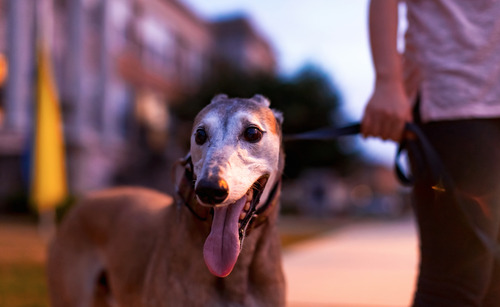If you’ve ever walked through a dark room at night with your dog close behind, you may have wondered: can dogs see in the dark? Many pet owners are curious about their dog’s vision, especially since dogs seem to move with confidence in low-light settings. Understanding how dogs see at night gives you a fascinating glimpse into how their senses differ from ours and why they might seem braver than we do when the lights go out. In this blog, we’ll explore how canine vision works, the science behind their ability to see in dim conditions, and what that means for life at home and outdoors.
How a Dog’s Eyes Are Built for Low Light
The first step to answering the question of can dogs see in the dark, is looking at how their eyes are structured. Dogs’ eyes share many similarities with human eyes, but there are key differences that give them an advantage at night. While humans rely heavily on cone cells for color and daytime vision, dogs have more rod cells, which are specialized for detecting motion and working in dim light. This rod-heavy retina is one of the main reasons dogs see better than we do in the dark.
The Tapetum Lucidum Advantage
Another special feature in a dog’s eyes is the tapetum lucidum, a reflective layer located behind the retina. This structure acts like a mirror, reflecting light back through the eye to give photoreceptor cells a second chance to capture it. The tapetum lucidum is also what makes dogs’ eyes appear to glow in the dark when a flashlight or car headlights shine on them. This adaptation is why dogs and many other animals are better equipped to see in low light compared to humans.
Comparing Dog Vision to Human Vision
When asking can dogs see in the dark, it helps to compare their abilities with our own.
Humans rely on high-definition, color-rich vision in daylight. However, once the sun sets, our eyes struggle to adjust. Dogs, on the other hand, sacrifice some clarity and color range in exchange for stronger night vision.
- Dogs see fewer colors: Their world appears in shades of blue and yellow, with less ability to distinguish between reds and greens.
- Dogs have wider visual fields: Thanks to the placement of their eyes, many dogs can see nearly 250 degrees around them, compared to our 190 degrees.
- Dogs detect motion faster: Even in dim light, their eyes are finely tuned to pick up subtle movements.
While humans excel at reading details on a page, dogs are better suited for spotting a squirrel moving across the yard at dusk.
How Well Can Dogs See in the Dark?
Now that we’ve covered structure and comparison, let’s answer the main question: can dogs see in the dark? The answer is yes, dogs can see much better than humans in dim conditions, but they do not have full night vision. Unlike nocturnal animals such as owls or cats, dogs cannot see in complete darkness. What they can do is make the most of minimal light sources, such as street lamps, moonlight, or even distant headlights. In practical terms, this means your dog can confidently navigate through a dark backyard or dimly lit room, even when you might be fumbling for a light switch.
Why Dogs Still Rely on Other Senses
Even though dogs can see in the dark, their vision is only one part of their sensory toolkit. Their highly developed sense of smell and acute hearing also help them interpret their environment. So when your dog moves confidently at night, it isn’t just their vision guiding them, it’s a combination of senses working together.
Common Myths About Dogs and Night Vision
There are many misconceptions surrounding the question of can dogs see in the dark. Let’s clear up a few of the most common ones.
Dogs Can See in Total Darkness
Dogs cannot see without any light at all. They need at least a small amount of light to make use of their night vision abilities.
Dogs See Just Like Cats at Night
Cats are more adapted to nocturnal life than dogs. While both animals have the tapetum lucidum, cats have even more specialized eyes for night hunting.
Dogs See Everything in Black and White
This isn’t true. Dogs see colors, but their range is limited compared to humans. They perceive mostly blues and yellows, which still provides them with useful information. By separating fact from fiction, pet owners gain a clearer understanding of what their dogs actually experience.
Why Night Vision Matters for Dogs’ Daily Lives
Knowing the answer to can dogs see in the dark isn’t just an interesting piece of trivia. It also helps explain many aspects of your dog’s behavior.
- Confidence on evening walks: Dogs often seem more comfortable than their owners on late-night strolls.
- Alertness to movement: If your dog barks at something outside after dark, it may be because they spotted motion that you didn’t.
- Adaptability indoors: Dogs can move around a dimly lit house without bumping into furniture, thanks to their ability to use low light.
These behaviors highlight how dogs’ vision shapes the way they interact with their surroundings.
Supporting Your Dog’s Vision as They Age
While dogs can see in the dark, aging may affect their eyesight. Senior dogs sometimes develop conditions that reduce their ability to navigate in dim light.
Signs Your Dog May Be Struggling at Night
- Hesitating before walking into dark rooms
- Bumping into furniture or doorways
- Increased anxiety in low-light settings
If you notice these changes, your veterinarian can help evaluate your dog’s vision and provide guidance.
A Deeper Appreciation for Your Dog’s Abilities
So, can dogs see in the dark? Yes, dogs see far better than we do in dim light, thanks to their rod-heavy retinas, wide visual field, and tapetum lucidum. While they can’t see in complete darkness, they use even the smallest amount of light to their advantage. Combined with their sharp sense of smell and hearing, dogs are well-equipped for nighttime adventures. At Berthoud Animal Hospital, we love helping pet owners learn more about the amazing abilities of their dogs. If you have questions about your pet’s vision or overall health, call us today at (970) 532-2726 or book an appointment online.





